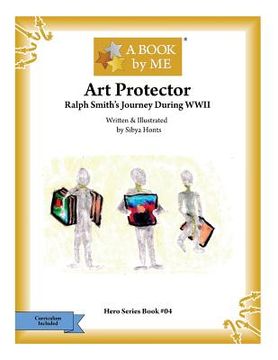Synopsis "Art Protector: Ralph Smith's Journey During WWII (in English)"
Ralph Smith was a small-town boy from Burnside, Kentucky, where he lived with his parents and sister Jo Anne. At age eighteen, he left his small-town roots behind, joining the army and heading for Europe to fight in World War II. He proudly sailed on the largest and fastest troop ship of the time, the RMS Queen Elizabeth across the Atlantic Ocean to Scotland. He took a train to England, where he boarded a ship to cross the English Channel to Le Havre, France. During the war, the army censored letters the soldiers sent home, checking to be sure they did not contain information that might be useful to the enemy. Ralph couldn't tell his family back home in Kentucky where he was or what he was doing. He was glad, when the war was over, finally to be allowed to tell them all about what he had done and where he had traveled. Until the war ended, his parents had no idea where their son was in Europe, but as long as they received letters from him, they knew he was safe. They were proud that their only son was fighting for freedom against tyranny. In a letter dated May 23, 1945, Ralph wrote to his parents, "Two weeks ago I was in Niedermarsberg one day, Brilon two days, and then me and three more GI's with three Yugoslavs went to guard Count Graf Spee's son's castle. That is where I was when the war ended. We were supposed to have been guarding $10,000,000 worth of art there. I saw the Count and we gave him orders instead of him ordering us. We stayed in the castle and slept in nice beds with clean sheets." After Hitler became Chancellor of Germany, one of his first acts was the "cleansing of the German culture," which included burning books and labeling art "degenerate" if it did not conform to Nazi ideology. "Degenerate" art included all types of modern styles and the work of any artist who was seen as not being racially "Aryan." Hitler made it a high priority to find and steal all degenerate art, and artists deemed degenerate were not allowed to paint. Besides destroying and discrediting "degenerate" art, Hitler also collected priceless masterworks for his own museum. He intended to stuff the museum full of the pieces he stole during the war, essentially consolidating all of the surviving great art in Europe in a single museum that would honor National Socialism, or Nazism. What Ralph guarded was most likely some of this art Hitler wanted for his museum, which had been stolen by the Nazis and later recovered by the Monuments, Fine Arts and Archives program of the Allies. The Monuments Men, as they were called, were a small group of mostly middle-aged men and a few women who interrupted their civilian careers as historians, architects, museum curators and professors to try to save irreplaceable items of art and culture. They found and recovered thousands of pieces of stolen art, traveling to areas the Nazis had occupied and searching out their art repositories. The art was often hidden in salt mines and caves. The Monuments Men also found vast amounts of gold and other precious materials the Nazis had plundered. The Allies collected the artworks and stored them at collection points until they could be returned to their rightful owners. Works of art that could be traced were returned to the countries from which they had been taken. After the war, Ralph returned to Kentucky and was able to attend college, thanks to the GI Bill. The Bill provided financial assistance to servicemen, veterans and their families to help pay for education or to buy a home. Ralph attended the University of Kentucky and became a mechanical engineer. He met Louellen, a woman with three brothers who had all served in the Navy during the war. One of her brothers was killed on an aircraft carrier; his body was never recovered. Ralph and Louellen married. Eventually they moved to the Quad Cities area of Illinois and Iowa, where Ralph worked for American Air Filter in Moline, Illinois, and they raised their three children.

